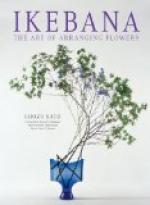|
This section contains 705 words (approx. 3 pages at 300 words per page) |

|
Ikebana: The Japanese Art of Flower Arrangement
Summary: Ikebana, a Japanese form of flower arrangement, originated in the 6th century as offerings in Buddhist temples. The form focuses on the harmony of shapes, colors and surroundings and is typified by elegance and grace.
If I were to ask a random person what he or she knew about ikebana flower styles, there is probably a large chance that that person wouldn't understand what I was talking about. Until a few decades ago, the term ikebana had no meaning to many non-Japanese people. Ikebana styles can be seen in almost any Japanese temple or Japanese ceremony. So, what exactly is ikebana? Ikebana is the Japanese art of flower arrangement (literally "living flowers").
Where did ikebana come from? It first originated in the sixth century as religious flower offerings in Buddhist temples. The offered flowers represented the faith of the followers. In the fifteenth century the simple style of offered flowers evolved into a complicated and formal style called rikka (standing flowers). Rikka arrangements symbolize the beauty of natural landscapes and usually were massive in size and very intricate. Because rikka styles required great...
|
This section contains 705 words (approx. 3 pages at 300 words per page) |

|


